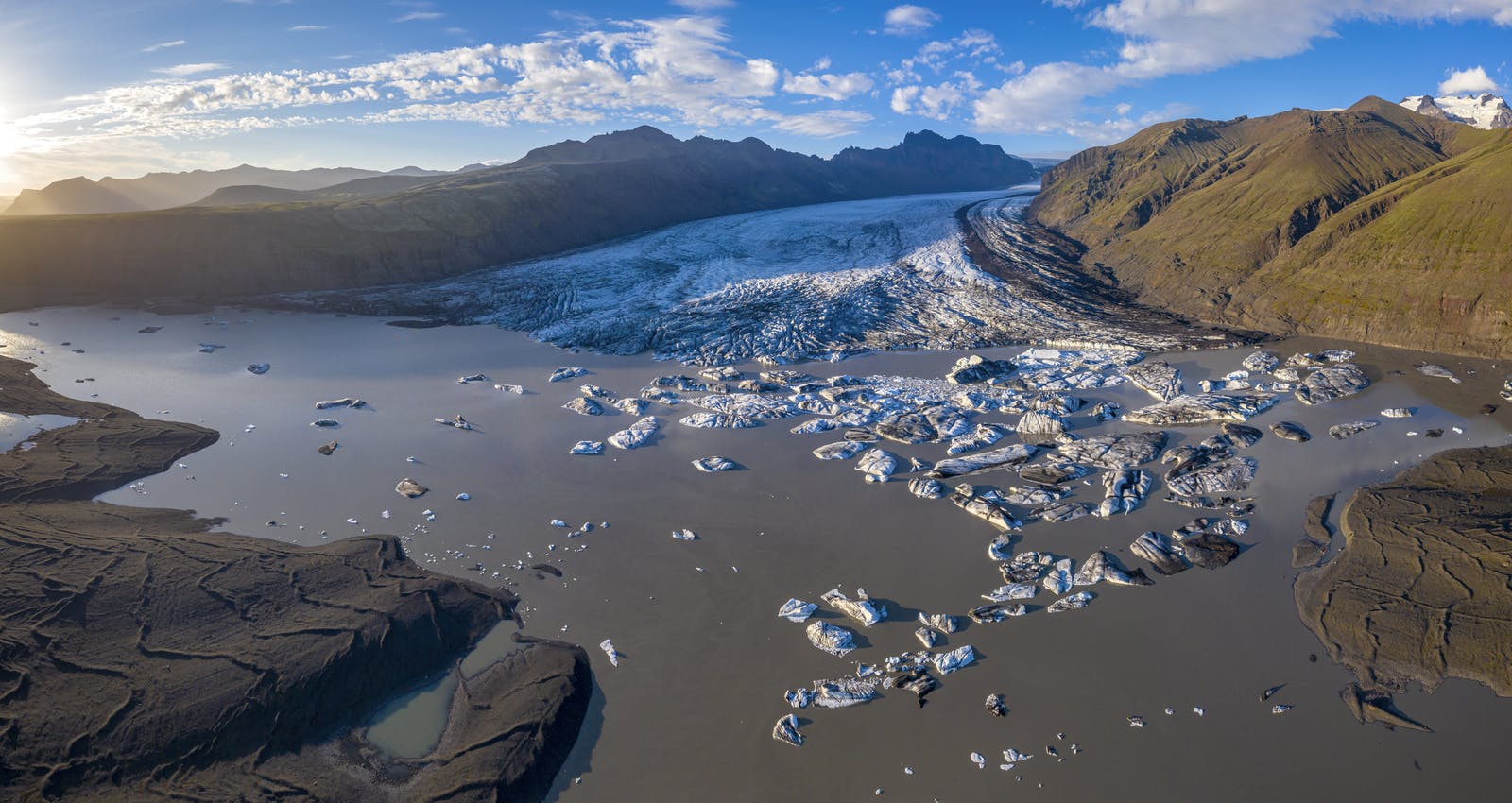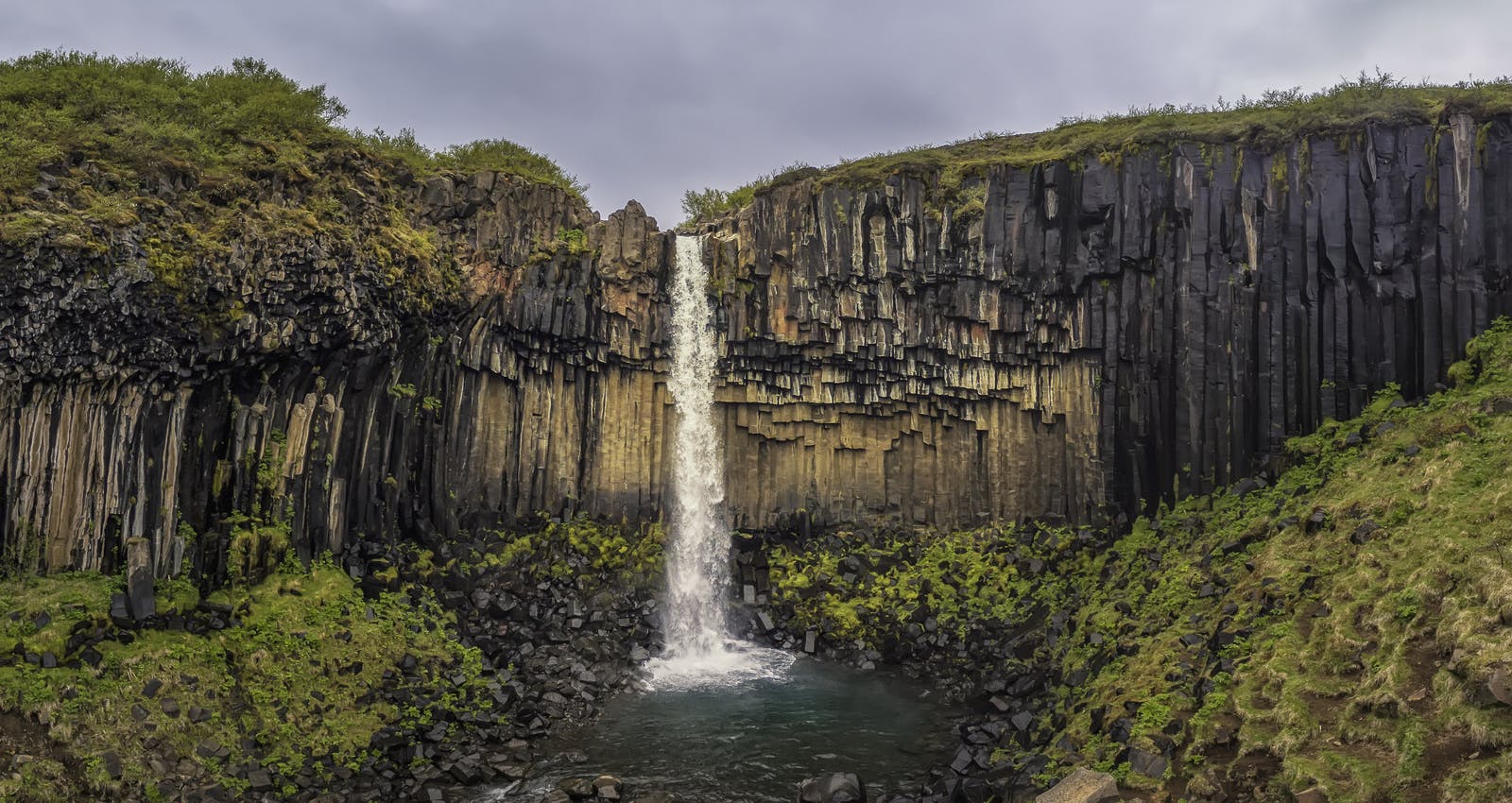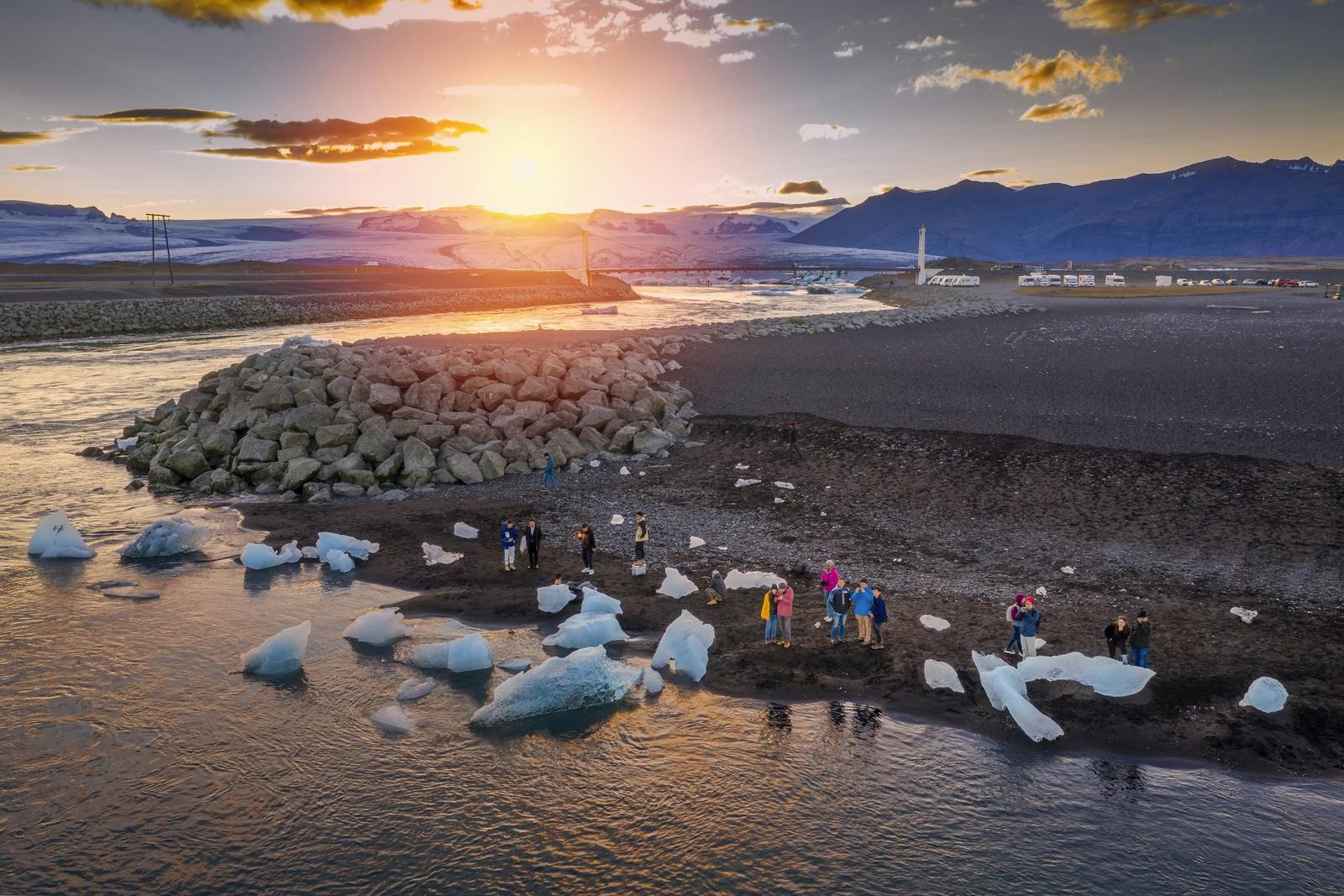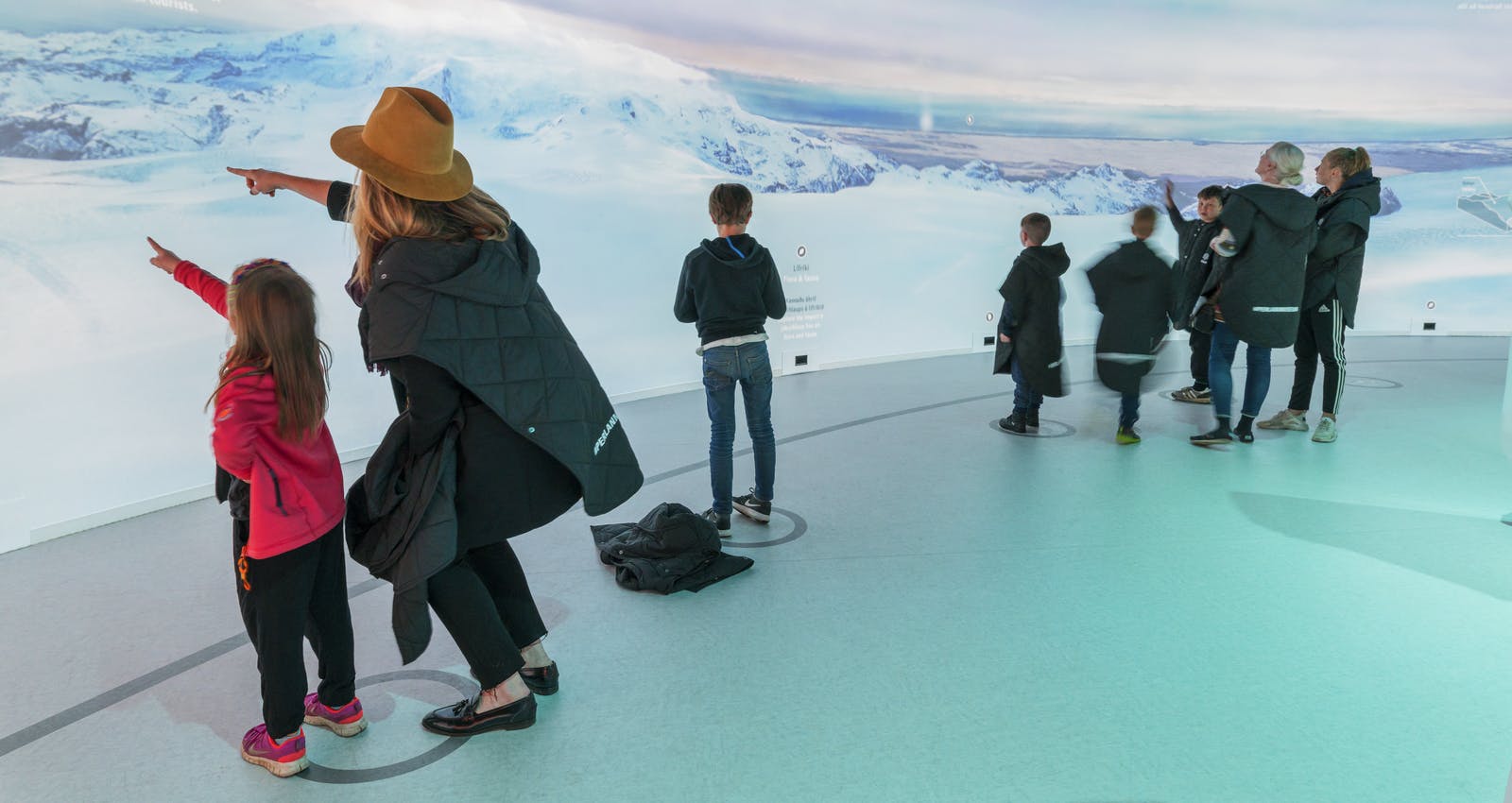
Guide to Skaftafell Glacier & Ice Cave
Skaftafell is a beautiful area within Vatnajökull National Park that offers a variety of hiking trails that lead to waterfalls, valleys and glaciers. Svartifoss, a waterfall surrounded by striking basalt columns, is a particular highlight.
What Can Tourists See in Skaftafell?
A common draw for many tourists is the black-sand beaches resulting from glaciers grinding down the bedrock. They’re particularly striking on clear days with the snowcapped mountains and blue skies in the background. Much of the black sand is carried to the sea by glacial rivers, the waves and winds shaping the sand into complex formations. In the westernmost part of the Vatnajökull region is 1,000-square-kilometer Skeiðarársandur, which is the largest black glacier sand area in the world. It can be accessed by Route 1.
Where is Skaftafell Located?
Skaftafell is situated within Vatnajökull National Park, which is the largest national park in Europe. It is in the southeastern part of Iceland, approximately 327 kilometres from Iceland‘s capital city of Reykjavík.
Can You See Glaciers in Skaftafell?
One of the most prominent features of Skaftafell is its glaciers. The most famous glacier in the region is the Skaftafellsjökull, an outlet glacier of the vast Vatnajökull ice cap. Visitors can explore the glacier and even take guided glacier hikes or ice-climbing tours.
What Outdoor Activities Can You Do in Skaftafell?

Skaftafell is a paradise for hikers and outdoor enthusiasts. Numerous hiking trails of varying lengths and difficulty levels make it accessible to a wide range of visitors. The most popular hike leads to Svartifoss, a stunning waterfall surrounded by basalt columns. Other hiking options include routes to glaciers, viewpoints, and more.
Can You See Ice Caves in Skaftafell?
Skaftafell is known for its crystal ice caves, which are found within the glaciers in the area. Ice caves are temporary natural structures that form in the deep winter months when subglacial rivers or meltwater create tunnels and caverns within the ice. The most famous ice cave in the Skaftafell area is the Crystal Ice Cave, but there can be others that vary from year to year.
What Attractions Are Close to Skaftafell?

Vatnajökull Glacier
Vatnajökull (Glacier of Lakes) is a fantastic spot to visit—quite literally, as it’s Iceland’s remaining piece of the last ice age. Vatnajökull features kilometres of pure ice intertwined with blue and smoky hues in interesting shapes formed by compression. It’s a wide-open space, sitting on top of active volcanoes. You will experience whipping winds, sky-high elevations, and cold temperatures.
Vatnajökull has the distinction of being the largest glacier in Europe . It spans 8,805 square kilometres, which covers about 8% of the country, and the average thickness is 400 meters.
Svartifoss

Svartifoss (Black Falls) is a picturesque waterfall in Skaftafell known for its unique hexagonal basalt columns surrounding it. A hike from the visitor centre will take you to this beautiful natural wonder.
Hundafoss
Hundafoss (Hound Falls) was named after the many dogs that were swept over the edge during floods. Be prepared to take a lot of pictures here. The falls are gorgeous in all seasons. The rocky terrain behind the falls is surrounded by beautiful greenery in the summer. The drop is steep, and the roar is soothing.
Hofskirkja Church
Located not far from Skaftafell, the Hofskirkja is a historic turf church that is both architecturally and culturally significant. It’s a beautiful example of Iceland’s traditional turf churches.
Jökulsárlón Glacier Lagoon
Jökulsárlón is a stunning sight that begs to be photographed. Chunks of ice are scattered about, walls of ice jut from the sea, and icebergs of various sizes float on the water. Huge blocks of ice constantly break off the Breiðamerkurjökull glacier into the lagoon, which, though not very wide, is up to 250 meters deep.
Diamond Beach

You can also venture to the river mouth and nearby Diamond Beach. Chunks of ice sometimes wash ashore and are scattered about like giant diamonds against a backdrop of black sand. The scene is spectacular any time of year but genuinely magical when the sun shines.
Fjallsárlón Glacier Lagoon
Located south of Skaftafell and Jökulsárlón, Fjallsárlón is another glacier lagoon where you can see icebergs up close in a more serene and less crowded setting.
Vestrahorn Mountain
Vestrahorn is a dramatic mountain range near Höfn, a little over an hour’s drive from Skaftafell. The jagged peaks and black sand dunes make it a popular photography spot.
Where Can I Learn About Glaciers in Reykjavík?

Perlan’s Wonders of Iceland exhibition features an ice cave that is 100 metres long, made from more than 350 tonnes of snow from Icelandic mountains. Ice caves are a natural phenomenon that takes shape in the deep winter months within glaciers. Meltwater streams carve these fantastic caves, and at Perlan, guests can see a real ice cave in a safe and secure environment. A visit to an ice cave is a magical experience that no one who comes to Iceland should miss, and Perlan offers year-round travellers a chance to get a sense of this unique natural phenomenon.
In addition to their natural beauty, Iceland’s glaciers are significant for the environment as they are an essential source of fresh water for the island and play a vital role in regulating the island’s climate.
At Perlan, guests can explore Iceland’s’ natural wonders through a series of exhibits and immersive presentations, including ice caves and glaciers, as well as northern lights and volcanoes.
FAQ

Is it safe to visit glaciers in Iceland?
Glaciers are perfectly safe from a distance, but travellers should never attempt to walk on a glacier without a trained glacier guide. Some snow-covered cracks and crevices can pose great danger to those unfamiliar with the surroundings. Guided tours are advisable to experience a glacier in Iceland fully.
Popular articles

Reykjanes Volcanoes Overview
Enjoy a complete overview of the Reykjanes Volcanoes from 2021-2024. Learn about its geology, recent activity, and visitor tips for a safe, memorable experience.

Reykjanes Peninsula Volcanoes: Sundhnúksgígar Eruptions
The anticipated volcano has erupted in the Reykjanes Peninsula, the site is being called Sundhnúkagígar. See the historic insights on the seismic activity and volcanic eruptions.

Earthquakes in Iceland
Earthquakes in Iceland are a fact of life. Each year, hundreds of small tremors shake the earth, a reminder of the country’s position on a tectonic plate boundary.

Volcano Museums and Exhibitions in Iceland
If you don't manage to visit an actively erupting volcano in Iceland - Experience its force at one of these excellent volcano museums and exhibitions in Iceland.

Top 10 Places To See the Northern Lights in Iceland
You can see the northern lights across the country, but some spots are more suitable than others. Find the best place to see the northern lights in Iceland.

Ice Caves From Reykjavik
Travel beyond the capital for a closer look at an ice cave under one of Iceland’s glaciers. If you can’t spare the time, experience Perlan’s ice cave in Reykjavik.